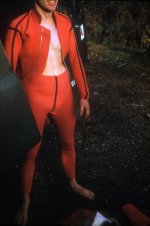One of our group of intrepid explorers spent a week cutting and gluing a Dolphin kit. First trip in P8 he found that using the correct glue would have been better. Bits of his effort were still circulating in the pool at the bottom of the first pitch a couple of weeks later.
Those of us who could not afford the lined kit put the single skin on inside out and glued nylon tights on.
Those of us who could not afford the lined kit put the single skin on inside out and glued nylon tights on.





